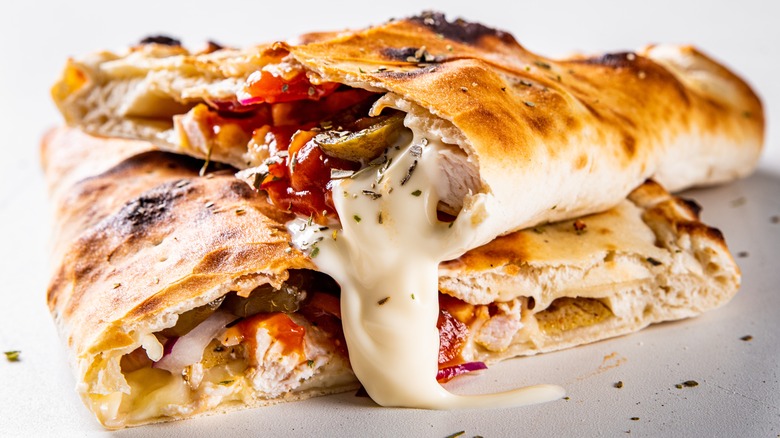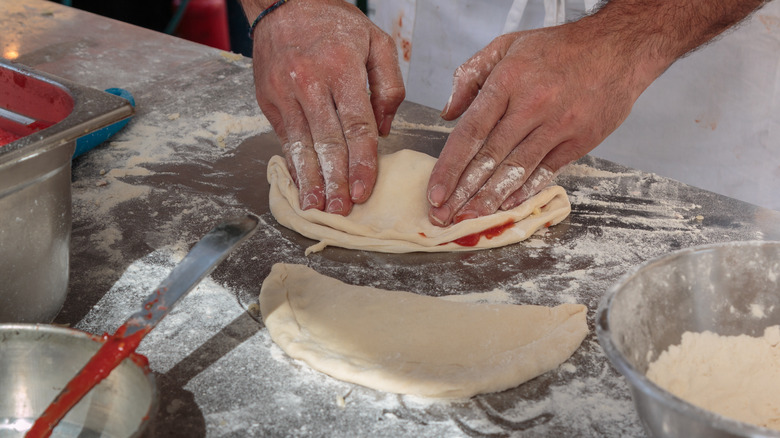The 18th Century Italian Origins Of Calzones
If a pizza and an empanada had a baby, it would probably look something like a calzone. Shaped like a dumpling with a pizza flavor, the calzone is a perfect mix of the two revered foods. It's not hard to figure out why some may think the calzone is an American invention. After all, it's in the same realm as the stromboli, created in Philadelphia in the 1950s, and the size of your corner pizzeria calzone is like everything else in America: supersized. But, just like the pizza, calzones are inherently Italian. In fact, they share the same birthplace as the pizza pie.
The ingredients that make up a calzone very much mirror what goes into pizza. It is essentially a dish consisting of dough and cheese, though you can stuff in all kinds of meats and vegetables. Because of the shape of the calzone, it might even be a bit less messy than eating a pizza. (Not that you care much when you're diving into a slice.) The two Italian foods even arrived in the U.S. via immigrants who took what they knew best and shared it to the delight of hungry Americans.
Pizza for walking?
In 18th-century Naples -– right around the time that pizza was taking shape in the spirited, working-class Italian city –- the calzone first came to life. It was a street food, intended to be purchased quickly and eaten on-the-go for the harbor town's busy workers. Pizza in Naples was also a working-class food, but seeing how it was flat, with sauce and toppings, it was eaten sitting down with a knife and fork. This wasn't convenient for a lot of people, so the calzone offered a suitable alternative. The word "calzone" is a loose translation of "trousers" or "pants legs," referring to the dish's relation to walking while eating. Traditional calzone is made without sauce, which can drip, thus ruining the intention of food to be eaten on foot.
Upon its invention, the calzone was much smaller than what Americans are accustomed to today. Roughly the size of a sandwich, it was meant to feed one person, versus modern versions which can easily feed several people. Pizza came to America thanks to Italian immigrants who brought their recipes and ingredients with them from their homeland. And we can only assume that calzones were brought to the U.S. in a similar fashion. Hardworking Italians looking to make a living opened up shops and carts offering the things they made in Italy, including calzones.
Limited only by your imagination
Calzones are sometimes referred to as inside-out pizzas and it's not difficult to see why. Pizza and calzone dough is the same, but instead of being flat with the toppings on top, calzone's "toppings" are inside the folded up and sealed dough which is always baked in a half-moon shape.
The original calzone fillings were not as elaborate as they are today, and were filled with cheap, local ingredients. Remember, it was a working-class food meant to be affordable to the masses. In his 1971 book, "The Food of Italy," Waverly Root writes that, once the calzone was invented, people realized it could withstand multiple ingredients. One early recipe included a filling of chicory hearts, anchovies, capers, black olives, currants, garlic, and egg yolk.
Once the calzone hit the streets of America, it transformed from street food into a regular menu item in many Italian restaurants. Now being offered as a sit-down meal, the size of calzones began to expand, as did the filling options. Today, a calzone's filling is only limited by your imagination. Typically, anything you put on a pizza you can put into a calzone, including vegetables and herbs. Ricotta cheese is also a popular cheese filling — since it's wet, it doesn't hold up well on top of pizza but stuffed into sturdy calzones, it gets soft and combines deliciously with mozzarella. Marinara sauce is usually still served on the side for dipping.
They are not all calzones
Depending on where you are in Italy — or America, for that matter — you may see something that resembles a calzone but isn't one. The idea of stuffed pockets of dough is genius, after all, and who wouldn't want to do a riff on it?
Take the panzerotti, for example. Like the calzone, the panzerotti is sort of an inverted pizza but is smaller in size. It originated in the Apulia region of Italy and, instead of being baked, it is deep fried. A little over 100 miles southeast of Naples sits the area of Basilicata where another calzone cousin resides: pastizz. Also known as u' pastizz 'rtunnar, it is a half-moon-shaped turnover made with dough and traditionally filled with pork before being baked.
In the tiny area of Lentini in Sicily, you can find cudduruni which is a type of focaccia dough that is either served as a flat, round disk topped with ingredients, or stuffed with fillings and folded over like a calzone. It was originally developed as a way to turn food scraps into a meal — it is traditionally filled with onion, tomato, sheep's milk cheese, and broccoli or other greens. Today, like the calzone, its fillings can include various meats and cheeses, even those not native to Sicily.
While calzones have evolved since the 1700s, they remain a filling, delicious meal with unmistakable Italian flavors, great for any night of the week.



